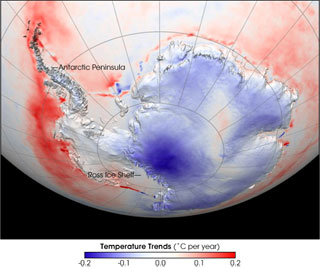Antarctic temperatures are not rising
Antarctic temperatures are not rising
mongabay.com
February 15, 2007
Temperatures in Antarctica are not rising as predicted by many climate models, according to research presented at the annual meeting of the American Association for the Advancement of Science in San Francisco. David Bromwich, researcher with the Byrd Polar Research Center at Ohio State University, reports that his work has found no increase in precipitation over Antarctica in the last 50 years. Most climate models predict that precipitation and temperature will increase over Antarctica as the planet warms.
“It’s hard to see a global warming signal from the mainland of Antarctica right now,” said Bromwich. “Part of the reason is that there is a lot of variability there. It’s very hard in these polar latitudes to demonstrate a global warming signal. This is in marked contrast to the northern tip of the Antarctic Peninsula that is one of the most rapidly warming parts of the Earth.”
Bromwich said the lack of data makes it difficult to forecast and measure changes on the icy continent.

Although Antarctica warmed around the perimeter from 1982 to 2004, where huge icebergs calved and some ice shelves disintegrated, it cooled closer to the pole. This image shows trends in skin temperatures—temperatures from roughly the top millimeter of the land or sea surface—not air temperatures. The data were collected by the Advanced Very High Resolution Radiometer (AVHRR) sensors that were flown on several National Oceanic and Atmospheric Administration (NOAA) satellites. The data come from the AVHRR’s thermal infrared channel—a portion of the light spectrum we can sense as heat but that human eyes cannot see. This image shows temperature trends for the icy continent from 1982 to 2004. Red indicates areas where temperatures generally increased during that period, and blue shows where temperatures predominantly decreased.
|
“The best we can say right now is that the climate models are somewhat inconsistent with the evidence that we have for the last 50 years from continental Antarctica,” he noted. “We’re looking for a small signal that represents the impact of human activity and it is hard to find it at the moment.”
Bromwich’s research found that over the past 10 years temperature and snowfall have dropped in Antarctica.
“What we see now is that the temperature regime is broadly similar to what we saw before with snowfall. In the last decade or so, both have gone down,” he said.
Bromwich theorized that ozone depletion over Antarctica could be affecting temperatures.
“If you have less ozone, there’s less absorption of the ultraviolet light and the stratosphere doesn’t warm as much,” he said. “In some sense, we might have competing effects going on in Antarctica where there is low-level CO2 warming but that may be swamped by the effects of ozone depletion. The year 2006 was the all-time maximum for ozone depletion over the Antarctic.”
Bromwich cautioned the disagreement between climate models and actual snowfall and temperature does not mean that the models are wrong.
“It isn’t surprising that these models are not doing as well in these remote parts of the world. These are global models and shouldn’t be expected to be equally exact for all locations,” he said.
This article is based on a news release, “Antarctic temperatures disagree with climate model predictions,” from Ohio State University.














